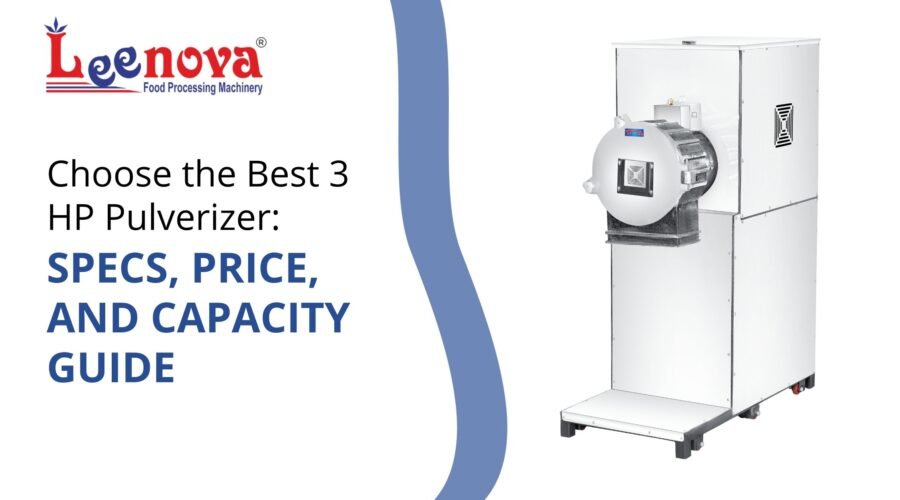While the pulverizer market races toward higher-horsepower industrial giants, smart money stays put at 3 HP.
The 3 HP segment dominates SME food processing for one brutal reason: it’s the exact inflection point where domestic power supply meets commercial output. Go higher, and you’re rewiring facilities. Go lower, and you’re accepting mediocrity. With over 15 years designing pulverizers that outlast their warranties, Leenova has watched countless operators learn this lesson the expensive way.
Understanding the Numbers: Key Specs and What They Mean
Motor Ratings: Single vs Three-Phase Reality
Most 3 HP units run at 2880 RPM with 30 kg/hour capacity, but RPM alone is useless without understanding torque curves. Single-phase motors deliver consistent power for grain processing, while three-phase setups handle harder materials like turmeric and dried chilies without thermal stress.
Chamber Design: The Airflow Advantage
Particle size control isn’t about mesh alone—it’s about airflow dynamics. Poor chamber design creates heat pockets that burn delicate spices and create uneven grinding. Leenova’s chambers use heavier-grade steel with optimized airflow patterns, delivering consistent particle distribution without the premium price of European imports.
Build Quality: Why Steel Grade Matters
SS304 versus SS316—most buyers obsess over this distinction while ignoring fabrication quality. Wall thickness, weld integrity, and bearing housing design determine longevity. Cheap units use 2mm walls; professional-grade machines start at 3.5mm.
Weight and Mobility: The Stability Trade-off
Heavier machines grind better. Period. A properly weighted 3 HP pulverizer (150-180 kg) stays planted during operation, reducing vibration that kills bearings. Leenova’s design philosophy: build heavy enough to last, light enough to relocate when business grows.
Single Chamber vs Double Chamber – The Real Performance Gap
Output Consistency: Where Double Chambers Shine
Single chambers excel at volume—one material, consistent particle size, maximum throughput. Double chambers handle variety: coarse grinding in the first stage, fine finishing in the second. The trade-off? Double chambers need 15-20% more power for the same output volume.
Overheating and Clogging: The Hidden Costs
Single chambers overheat faster with oily materials like sesame or flax. Double chambers distribute thermal load but clog more frequently with fibrous materials. Smart operators match chamber design to their primary ingredients—not their wishlist.
When to Pick One Over the Other
Choose single chamber for: High-volume single ingredients, consistent daily batches, maximum efficiency. Choose double chamber for: Multiple ingredients daily, varying particle sizes, premium finish quality.
Leenova’s comparative advantage: Our single chamber models include noise dampening that outperforms most double chamber competitors, while our double chamber variants feature tool-free cleaning access that cuts maintenance time by 40%.
Price Isn’t the Whole Story – Total Cost of Ownership
Upfront Costs vs Operating Life
Market pricing starts around ₹50,800 for basic 3 HP units, but cost-per-kg over five years tells the real story. Premium units with superior bearing systems and motor protection cost 30% more upfront but deliver 60% longer service life.
Blade and Mesh Replacement
Generic imports burn through blades every 200-300 hours. Quality machines push this to 600-800 hours. At ₹2,500 per blade set, this difference pays for itself within 18 months. Leenova clients report 40% fewer mesh replacements annually due to our precision-balanced rotor design.
Energy Efficiency’s Real Impact
A 10% efficiency improvement saves ₹15,000 annually in electricity costs for businesses running 6-8 hours daily. Most buyers ignore this—until they see their first year’s power bill.
Material Compatibility and Recipe Versatility
Hardness Scale: What Works Where
Grains (hardness 3-4): Any decent 3 HP handles wheat, rice, and corn effortlessly. Spices (hardness 4-6): Turmeric and coriander need proper blade angles and chamber geometry. Herbs (hardness 2-3, fibrous): The real test—herbs clog inferior designs instantly. Pulses (hardness 5-7): Lentils and chickpeas separate quality machines from pretenders.
Fine vs Coarse Grinding Sweet Spots
Mesh size isn’t everything. Chamber velocity, blade configuration, and residence time determine actual particle distribution. Leenova’s tested ingredient database specifies optimal mesh sizes for 150+ materials—turning guesswork into precision.
Quick Start Setup and First-Run Tips
Foundation: The Overlooked Essential
Proper foundation installation is mandatory for smooth operation. Skip this, and you’ll fight vibration issues forever. Concrete pad minimum: 50cm x 50cm x 15cm deep.
Ventilation: Heat Management
Position exhaust fans within 2 meters. Poor ventilation creates moisture buildup that ruins motors and rusts chambers. Leenova’s Ready-to-Run advantage eliminates guesswork—pre-tuned alignment and factory lubrication mean you’re grinding within hours, not days.
Maintenance Made Simple
Daily: The 5-Minute Rule
Clean the chamber, check blade clearance, and inspect collection bags. Five minutes prevents five-hour repairs.
Weekly: The Critical Checks
Belt tension, bearing temperature, motor amperage draw. Catch problems early or pay exponentially later.
Blade Sharpening: Timing Is Everything
Sharpen blades at the first sign of increased power draw or reduced output—waiting for dull blades damages chambers and overworks motors. Leenova’s Easy-Access design allows blade changes without complete disassembly, cutting downtime from hours to minutes.
Buying Checklist – Choose Smart
Assess Your Reality
- Available power: Single- or three-phase?
- Space constraints: Foundation possible?
- Noise tolerance: Neighbors matter
- Daily batch size: Match capacity realistically
Match Machine to Materials
- Single ingredient focus = Single chamber efficiency
- Multi-ingredient variety = Double chamber flexibility
- Oily materials = Enhanced motor protection essential
Download Leenova’s Selection Guide for side-by-side specs of our complete 3 HP range—including hidden specifications most manufacturers won’t publish.
People Also Ask
Can I run it on domestic power? Yes, but verify your main breaker capacity. 3 HP draws 12-15 amps at startup.
Does it handle oily seeds? Quality machines handle 15-20% oil content without issues. Cheaper units clog at 10%.
How often should I replace blades? Professional use: 6-8 months. Light commercial: 12-15 months. Home scaling: 18-24 months.
Leenova’s blade life consistently exceeds these benchmarks due to superior metallurgy and precision balancing—verified by independent testing at IIT Kanpur’s food processing lab.
The Most Important Thing For You
For startup food brands: Single chamber, 3 HP with quality motor protection. Efficiency trumps features early on.
For busy restaurants: Double chamber for versatility, heavy-duty construction for reliability. Leenova’s R-Series handles the punishment.
For home millers scaling up: Single chamber with upgrade path. Leenova’s M-Series grows with your business—same mounting footprint, higher HP options available.
Ready to move beyond generic options? Contact Leenova Kitchen Equipments for engineering-grade solutions that work as hard as you do.


